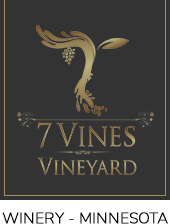One grape with unlimited possibilities, and four fabulous Frontenac wines
Sit back with a glass of wine, and enjoy this tale of three Frontenacs.
Minnesota has a difficult climate. I probably don’t even need to tell you that, since most MN Uncorked readers are from the Midwest, but you might be interested to know that since 1887 the University of Minnesota has been developing trees, shrubs, grasses, flowers and fruit to flourish here in spite of the bitter cold winters and hot, humid summers.
Perhaps among the best known fruit developed by the U of M are apples, inducing popular varieties such as Honeycrisp, Zestar!®, Rave®, First Kiss®, and SweeTango®.
In the 1970’s a wine grape breeding program was added to their roster of specialities which has resulted in the release of several celebrated wine grape varieties, among them are Frontenac (1996), a red grape; Frontenac Gris (2003), a pinkish-gray skinned berry; and Frontenac Blanc (2012), a white grape.
Deviating from the norm
The change in skin color for the Frontenac Gris and Frontenac Blanc grapes are a mutation, or a a slight genetic difference. Mutations can result in a trait that could be favorable, unfavorable, or negligible from the original.
You might be familiar with wine grape mutations such as Pinot Noir, Pinot Gris (Pinot Grigio) and Pinot Blanc, which likely transformed hundreds of years ago and have since been cultivated worldwide. It was actually through DNA prototyping results published in 2000 that confirmed the Pinots’ lineage (Regner et al. 2000).
In the case of Frontenac, Minnesota’s vintners actually got to see it happen, noticing changes in their vines from black-skinned berries to pinkish-gray (gris), and white (blanc).
Breeding the mutated vines creates more of the same, and extensive winemaking and analysis of the results deemed Frontenac Gris and Frontenac Blanc also fit for winemaking, named and released for commercial use.
What I’ve summed up into a few lines above is astonishingly complex. If you’re ready for another glass of wine head on over here to read more about the process of developing new wine grape varieties.
Fast-forward to the incredible wines being made from Frontenac today, which is increasingly becoming one of my favorite local varietals. From stunning, tropical fruited white wines to smooth, decadent reds and gorgeous late-harvest and port style wines, I’m wild about what I’m seeing from the varietal. Here are a few examples:
7 Vines Vineyard Frontenac Blanc 2017
A decadent gold color. Ripe tropical fruit (pineapple) followed by developing aromas of petrol, dried apricot, honey, and candied orange. The wine is dry with high acidity, and medium body with flavors of lemon, fresh apricot, and tart pineapple, with a lengthy finish.
Pairing suggestion: Due to the backbone of acidity in this wine, imagine this would be a delightful pairing with something salty – perhaps prosciutto wrapped walleye, or pasta con pancetta.
Round Lake Vineyards Frontenac Gris 2017
A rich, salmon hue. Floral aromas, ripe peach, apricot, and fresh strawberry jam. The wine is semi-dry, balanced by moderately high acidity and medium-bodied with flavors of tangerine, grapefruit and strawberry.
Pairing suggestion: The wine has a slight sweetness that would play well with spicy asian dishes.
Carlos Creek Winery Frontenac Reserve 2017
Rich ruby color with a hint of brown. Fragrant, ripe red cherries and red currant with developing aromas of baking spice, vanilla, and a light herbal note. The wine is dry, with moderately high acid, medium body, and moderately light tannins that are smooth, and very well integrated. Flavors of cherry and baking spice mirror the nose, in addition to sweet tobacco, and a spicy herbaceous quality.
Pairing suggestion: The sweet/savory interplay of this wine would be a great pairing to seared duck in cherry sauce.
Parley Lake Winery Frontenac Dessert Wine 2016
A deep ruby color. Developing aromas of dried cherry, chocolate, and sweet spice like anise, licorice and vanilla. The wine is semi-dry with moderately high acid, medium body, and moderate, soft tannins. Flavors mirror the nose of cherry and chocolate, followed by and herbaceous and spicy quality.
Pairing suggestion: Give me a snifter of this and call me a happy gal — but if you must, try it alongside a cherry crisp and let me know how it goes.
Samples of these wines were provided by the producers, at my request. Do you have a wine you’d like to see on Minnesota Uncorked? Drop me a line, I’d love to hear from you
 7 Vines Vineyard Homepage
7 Vines Vineyard Homepage